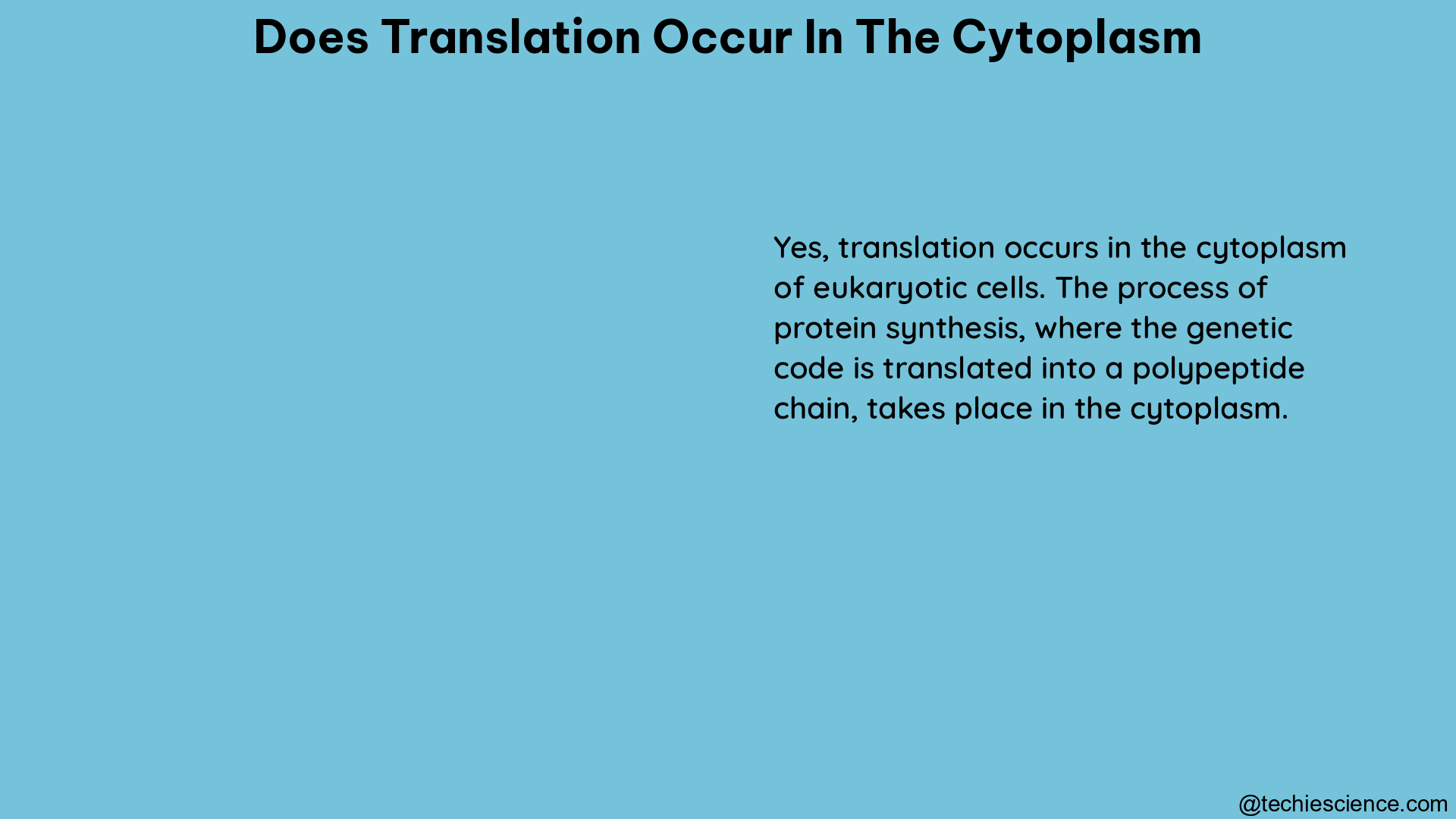Translation, the second step of protein synthesis, is a crucial cellular process that takes place in the cytoplasm of both prokaryotic and eukaryotic cells. This intricate process involves the decoding of the genetic information stored in messenger RNA (mRNA) to produce functional proteins, which are the building blocks of life.
The Cytoplasm: The Site of Translation
The cytoplasm is the gel-like substance that fills the interior of a cell, excluding the nucleus and other organelles. It is within this dynamic environment that the translation machinery, including ribosomes, transfer RNAs (tRNAs), and various enzymes, come together to synthesize proteins.
Ribosomes: The Protein Synthesis Factories
At the heart of the translation process are the ribosomes, which are complex molecular machines composed of ribosomal RNA (rRNA) and proteins. Ribosomes are responsible for decoding the mRNA sequence and catalyzing the formation of peptide bonds between amino acids, ultimately assembling the polypeptide chain that will fold into a functional protein.
In eukaryotic cells, ribosomes can be found in two distinct locations:
-
Free Ribosomes: These ribosomes float freely in the cytoplasm and are responsible for the synthesis of proteins that will be used within the cell, such as enzymes and structural proteins.
-
Membrane-Bound Ribosomes: These ribosomes are attached to the rough endoplasmic reticulum (rER), a network of interconnected membranous structures within the cytoplasm. The ribosomes on the rER are responsible for the synthesis of proteins that will be transported to other organelles or secreted from the cell, such as hormones and antibodies.
The Mechanism of Translation
The translation process can be divided into three main stages:
-
Initiation: The mRNA molecule, which carries the genetic information from the nucleus to the cytoplasm, binds to the small ribosomal subunit. The initiator tRNA, carrying the amino acid methionine, then binds to the start codon (AUG) on the mRNA, forming the complete ribosome.
-
Elongation: The ribosome moves along the mRNA, reading the genetic code in triplets (codons) and recruiting the appropriate tRNAs, each carrying a specific amino acid. The amino acids are then joined together to form the polypeptide chain.
-
Termination: When the ribosome reaches a stop codon (UAA, UAG, or UGA) on the mRNA, the completed polypeptide chain is released, and the ribosome disassembles.
The Importance of Cytoplasmic Translation
The localization of translation in the cytoplasm is crucial for several reasons:
-
Spatial Separation: In eukaryotic cells, the separation of transcription (in the nucleus) and translation (in the cytoplasm) allows for more efficient regulation and coordination of gene expression.
-
Protein Targeting: The cytoplasmic location of translation enables the targeting of proteins to specific cellular compartments, such as the endoplasmic reticulum, Golgi apparatus, or mitochondria, through the use of signal sequences.
-
Protein Folding and Modification: The cytoplasmic environment provides the necessary conditions for the proper folding and post-translational modification of newly synthesized proteins, ensuring their functional integrity.
-
Rapid Response: The cytoplasmic localization of translation allows for a more immediate response to changes in the cellular environment, as mRNA can be quickly accessed and translated without the need for transport from the nucleus.
Cell-Free Gene Expression Systems

In addition to the in vivo translation that occurs in the cytoplasm of living cells, researchers have developed cell-free gene expression (CFE) systems that can recapitulate the transcription and translation processes in vitro. These systems, which rely on the cytoplasmic machinery, have become valuable tools for studying the dynamics of protein synthesis and for the production of recombinant proteins.
One such system is the PURE (Protein synthesis Using Recombinant Elements) system, which is a purified, reconstituted system composed of the essential components required for translation, including ribosomes, tRNAs, and translation factors. The PURE system has been shown to be more tractable for modeling the biochemical reactions of transcription and translation compared to lysate-based systems, which contain a complex mixture of cellular components.
Conclusion
In summary, translation, the process of converting the genetic information encoded in mRNA into functional proteins, occurs exclusively in the cytoplasm of both prokaryotic and eukaryotic cells. The cytoplasmic location of translation is crucial for the spatial separation of transcription and translation, the targeting of proteins to specific cellular compartments, and the proper folding and modification of newly synthesized proteins. Additionally, cell-free gene expression systems, such as the PURE system, have been developed to study the dynamics of translation in vitro, further highlighting the importance of the cytoplasm as the site of protein synthesis.
References:
- Socratic. Where does transcription occur and where does translation occur in the cell? https://socratic.org/questions/where-does-transcription-occur-and-where-does-translation-occur-in-the-cell
- Reddit. Translation in eukaryotes. https://www.reddit.com/r/Mcat/comments/gxfoot/translation_in_eukaryotes/
- Quizlet. Translation, Plasmids and Transformation, and transport of mRNA from nucleus to cytoplasm. https://quizlet.com/466522474/translation-plasmids-and-transformation-and-transport-of-mrna-from-nucleus-to-cytoplasm-flash-cards/
- Quizlet. Topic 6.4: Translation. https://quizlet.com/693593823/topic-64-translation-flash-cards/
- Nature Reviews Methods Primers. Cell-free gene expression. https://www.nature.com/articles/s43586-021-00046-x
Hey! I am Sneha Sah, I have completed post graduation in Biotechnology. Science has always been fascinating to me and writing is my passion. As an academic writer my aim is to make Science easy and simple to learn and read.